Introduction
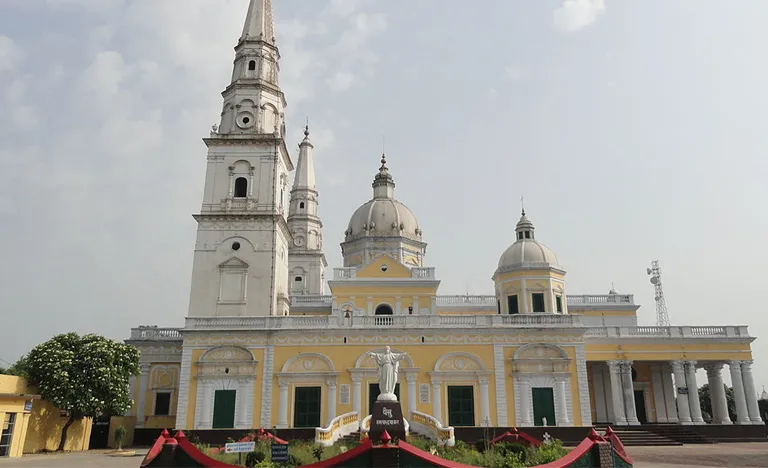
The Basilica of Our Lady of Graces, Sardhana is the largest Roman Catholic Church in the entire North India. This majestically built marble monument stands tall in the heat and dust of the northern plains like a refuge of concord and tranquility. Also, known as the ‘Churches among the churches,’ the Basilica of Our Lady of Graces is dedicated to the Virgin Mary. Inspired by St. Peter’s Basilica in Rome, this mini basilica was designed by Italian architect Antonio Reghellini, who used a touch of Palladio along with Indian architectural influence to construct the monument.
An out-and-out marble structure, the altar, and its surrounding area are etched with vibrant marble colored stones. The octagon-shaped dome adds further beauty to the church as it illuminates the interiors when sunlight streams in. The entire church is adorned with semi-precious stone work, stylized by a Greek colonnaded veranda, an elevated altar and three Roman domes that add to the building’s grandeur.
Outside the church, sprawls a lush green sanctuary that houses the majestic 18 feet high edifice of Begum Samru smoking hookah, which was carved by Italian sculptor Adamo Tadolini and transported to Sardhana from Italy to Kolkata via ship. Basilica of Our Lady of Graces is a Roman Catholic Church in Sardhana, 19 km northwest of Meerut, in the Indian state of Uttar Pradesh. This is a fine catholic church built by a benevolent Muslim Queen by the name of Zebunnissa.
History of Basilica of Our Lady of Graces, Sardhana
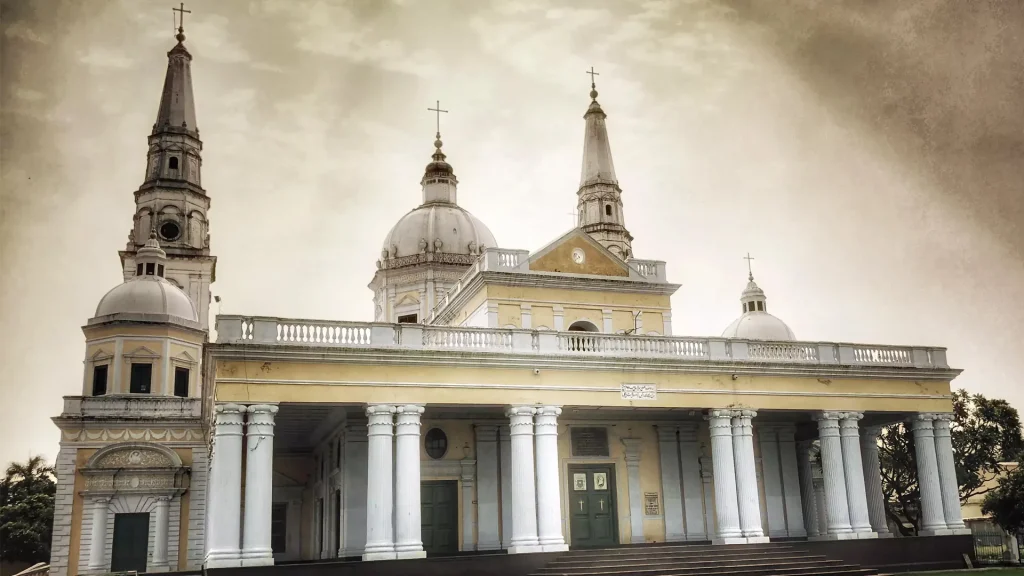
Begum Samru inherited the Jagir of Sardhana after her husband’s death in 1778. Subsequently, she decided to construct a Church at Sardhana, dedicated to Virgin Mary. The construction of the Church cost Rs. 4 lakh, a huge amount in those days. Top masons were paid the equivalent of 25 p. per day, and the labourers in shells. Two huge lakes near the church are the result of the mud that was removed to supply the building material for the church. Two dates are often given for the beginning of the church – Mr. K. M. Munshi, the noted historian, gives the date as 1809. Many are inclined to follow this date because a Latin inscription over the main door of the church puts its dedication in 1822. The other date, given by Fr. Keegan in his study of the Begum, is 1820.
Begum Samru requested the Pope to make Sardhana an independent circumscription. In 1834, Pope Gregory XVI established the Apostolic Vicariate of Sardhana from the Apostolic Vicariate of Tibet-Hindustan and appointed Bishop Julius Caesar Scotti as the Apostolic Vicar. The church was the cathedral of Sardhana. However, Scotti was the only Vicar Apostolic, and eventually, the Apostolic Vicariate of Sardhana was merged into the Apostolic Vicariate of Agra.
Our Lady of Graces is a tribute to a formidable ruler
Tucked away in the dusty town of Sardhana, an hour-and-a-half’s drive from Delhi is the largest church in north India. Now declared a minor Basilica, the church of Our Lady of Graces is a beautiful monument and a tribute to an amazing woman. No one knows the birth name of the petite Kashmiri dancing girl with sparkling eyes and mesmerizing smile, but she is remembered as Begum Samru, the only Roman Catholic ruler in India.
Coronation of Mary
Coronation of Mary as Queen of the Heavens by her son, Jesus Christ, during the Assumption of Mary, is a tradition known since the 12th century.
Queen of Heaven (Latin Regina Caeli) is one of a number of titles used particularly for Mary, the mother of Jesus. The title is with reference to the end of her earthly life when Mary was bodily assumed into heaven. There she is honoured as Queen, for the sake of her Son.
- As Mary enters heaven, the entire court of heaven greets with joy this masterpiece of God’s creation.
- Mary is crowned by her divine Son as Queen of heaven and earth.
- More than we can ever know the Hearts of Jesus and Mary overflow with joy at this reunion.
- Only in heaven will we know the great majesty of that coronation, and the joy it gave to the angels and saints.
- Even the angels, who by nature are greater than humans, hail Mary as their Queen.
- Mary shares so fully in the glory of Christ because she shared so fully in his suffering.
- From her throne, Our Mother dispenses love and peace to men.
- The angels and saints longed for the coming of her whose heel crushes the head of the serpent.
- Mary pleads our cause as a most powerful Queen and a most merciful and loving Mother.
- A great sign appeared in heaven; a woman clothed with the sun, the moon under her feet, and on her head a crown of twelve stars.
Our Mother Mary
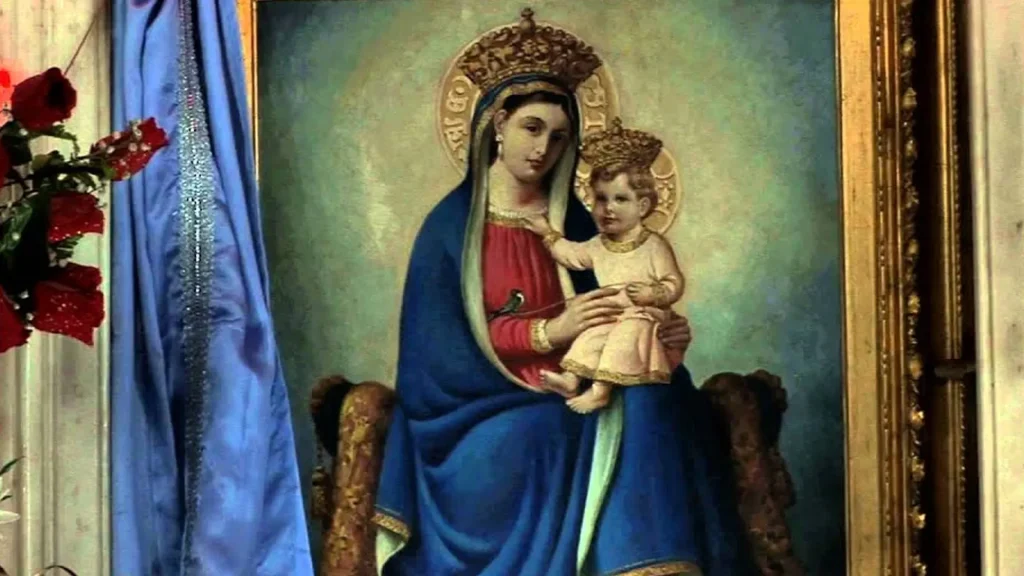
Closely related to the title Mother of God is the title Virgin Mary, affirming the virginal conception of Jesus (Luke 1:35). God, not Joseph, was the true father of Jesus. In the Marian devotion that developed in the East in the 4th century, Mary was venerated not only in the conception but also in the birth of Jesus. This conviction was expressed clearly in the 4th century, baptismal creeds of Cyprus, Syria, Palestine, and Armenia.
The title used was Aieiparthenos (ever-virgin), and by the middle of the 7th century the understanding of the title came to include the conviction that Mary remained a virgin for the whole of her life. This notion reinforces the idea that Mary was not touched by this world, indeed her purity of spirit, body and mind signaled her attachment to the realms of the Gods. The passages in the New Testament referring to the brothers of Jesus (for instance, Mark 6:3, which also mentions sisters; see 1 Corinthians 9:5; Galatians 1:19) have been accordingly explained as references to relatives of Jesus or to children of Joseph by a previous marriage.
In the 2nd and 3rd centuries, various Christian writers began to express the belief that, because of her intimate union with God through the Holy Spirit in the conception of Jesus, Mary was completely free from any taint of sin. In 680AD a Roman Council spoke of her as the “blessed, immaculate ever-virgin.” This can be taken one step further it can be suggested that Mary completed the “Holy Trinity” not that she was touched by the Holy Spirit, but that she was the Holy Spirit. Who else could have born the Son of God on earth? Thus completing the Holy Trinity – God the Father, God the Son and God the Mother.
During the late Middle Ages (13th century to 15th century), devotion to Mary grew dramatically. Mary came to be depicted as the one who interceded for sinners. As the fear of death and the Last Judgment intensified following the Black Plague in the 14th century, Mary was increasingly venerated in popular piety as mediator of the mercy of Christ. Her prayers and pleas were seen as the agency that tempered the stern justice of Christ. Indeed Christ had talked of the Comforter, Councillor and Redeemer who would come at the time of the Last Judgment. People turned to Mary for God’s compassion, recognising these as feminine qualities, the qualities of a Mother.
Mary and the Gospels
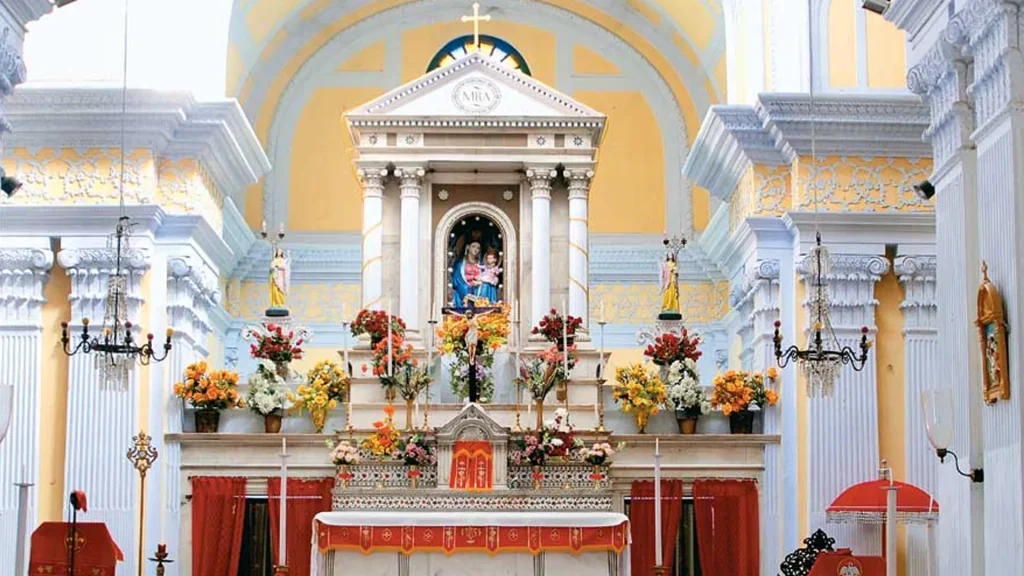
The most comprehensive stories about the early childhood of Mary are attributed to the Gospel of Luke and the Gospel of James. This has been documented by historians as being written prior to the year 200 AD.
In a document called God the Father of Mercy there is an entire chapter devoted to Mary, the Holy Trinity’s Sign of Mercy. Mary is the object of God’s mercy. This document states:
“Mary becomes the prophet of God’s mercy, as well as it’s icon. She, more than anyone else knows the mystery of mercy that reaches its climax on Calvary. The Virgin who became the Mother of Jesus at Christmas, enabling God’s mercy to become incarnate.”
The qualities of mercy, compassion, comforting and counselling have long since been seen as feminine qualities, all of which Mary emanated. They are also the qualities of the future incarnation promised by Christ, “But the Comforter, which is the Holy Ghost, whom the Father will send in my name, shall teach you all things” (John 14:26) Could it be that he was telling then of the age of the Mother, when the feminine power of God would grace this earth.
Feast Day - 14th November
Our Lady Of Graces, Annual Pilgrimage, Sardhana 14th November
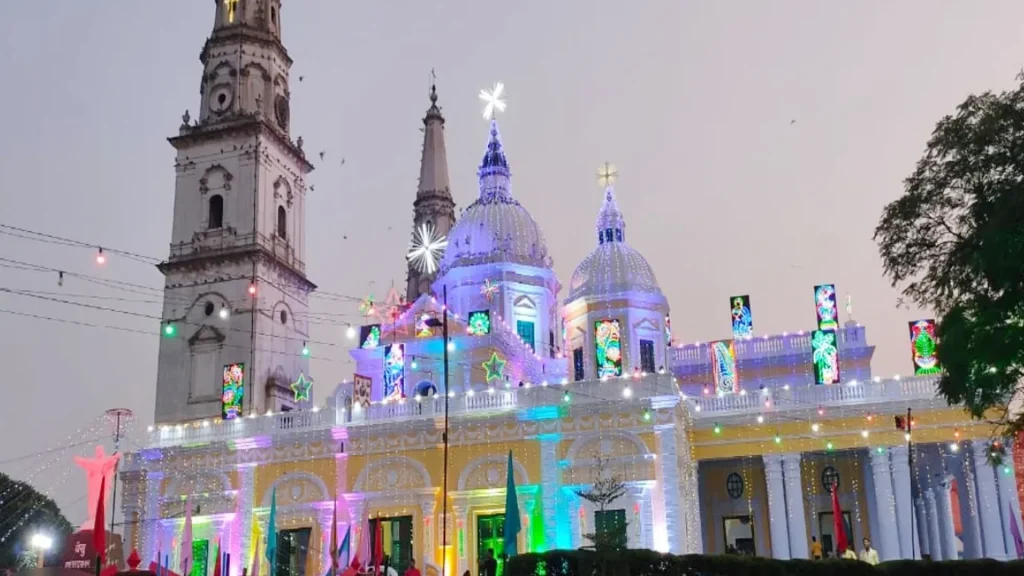
According the traditions of the Orthodox and Catholic Church, the Blessed Virgin Mary having completed the course of her earthly life, was assumed body and soul into heavenly glory. This means that Mary was transported into Heaven with her body and soul united. The feast day recognizing Mary’s passage into Heaven is celebrated as The Feast of the Assumption of the Blessed Virgin Mary.
Mass Time
Open Hours
- Daily 7.00 a.m. to 5.00 p.m.
Times of Liturgical Celebrations
- Daily Holy Mass:
- Summer: 6.00 a.m.
- Winter: 7.00 a.m.
Sunday Holy Mass:
- Summer: 7.30 a.m., 9.30 a.m., 11.30 a.m.
- Winter: 8.00 a.m., 9.30 a.m., 11.30 a.m.
Holy Hour on Fridays
- Summer: 5.30 p.m.
- Winter: 4.30 p.m.
Rosary, Novena & Benediction
- Summer: 5.30 p.m. on Sat. & Sun.
- Winter: 4.30 p.m. on Sat. & Sun.
Contact Info
Basilica of Our Lady Of Graces,
Church Road, Sardhana,
Meerut District – 250 342,
Uttar Pradesh, India
Phone No.
Parish Priest:
Mobile Contact: +91 6398754688
Administrator:
Mobile Contact: +91 8445186914
Accommodations
Connectivity
Basilica of Our Lady of Graces, Sardhana, Uttar Pradesh is well connected with Bus Station, Railway Station and Airport facilities rest of the country.
Airways
Dr. Bhimrao Ambedkar Airstrip is an airstrip-aerodrome, situated at Partapur, 9 km south of Village Gagol of Meerut, in Uttar Pradesh, India. Which is (34.1 Kms) from Basilica of Our Lady of Graces, Sardhana.
Railways
The nearest railway station is Daurala train station, meerut district which is (11.1 Kms) from Basilica of Our Lady of Graces, Sardhana.
Roadways
The nearest Meerut Bus Station is (1.3 Kms) from Basilica of Our Lady of Graces, Sardhana.







